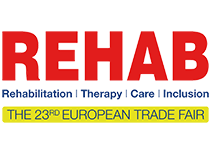Neurorehabilitation: When scientific approach meets old ways of thinking and stubborn misconceptions
Neurorehabilitation (NR) is changing and is also fighting against misconceptions in training. At the CON.THERA trade congress, which will take place parallel to REHAB from 15 to 17 June 202, Sabine Lamprecht will present the ten biggest misconceptions in
Neurorehabilitation aims to help patients with neurological conditions live as independently as possible through physical activities. Following diagnosis of the patient’s functional or social limitations, therapists can discuss the specific treatment goals with them. The aim here is to coordinate the entire interdisciplinary team of ergotherapists, physiotherapists, speech therapists, neuropsychologists, care and social workers, doctors and orthopaedic technicians. Should a patient need rehabilitation and orthopaedic treatment, they can undergo a training course catered to their needs that uses three approaches:
1. Repeating simple activities over and over again teaches the brain to develop new structures and replace damaged ones.
2. Continuously adjusting the level of difficulty to the patient’s limits leads to improvements.
3. A series of varied training units that are practically focused on everyday life help to convince and motivate the patient.
Scientifically developed guidelines are changing neurorehabilitation, while those training the next generation of therapists are confronting persistent myths.

From healers to coaches – how scientific approaches are breaking down old ways of thinking
Sabine Lamprecht is a tutor, author and physiotherapist with a master’s degree in neurorehabilitation. She has led an interdisciplinary therapy clinic with her husband for several years and explains what has changed in that time:
“The way that practitioners see themselves has changed enormously in the 40 years that I’ve spent in this sector. Neurorehabilitation aims to restore lost capabilities. But rather than doing it for the patients, we help them do it themselves. We are no longer “healers”, but more like coaches who support people on their journey towards self-empowerment.”

Looking back, Lamprecht recalls: “Neurorehabilitation is an overwhelmingly therapeutic procedure. When I started my career, our work was based on empirical knowledge and assumptions. Observations in treatment sometimes led to conclusions that cannot be proven today with scientific approaches.”
In her work as a tutor too, Lamprecht encounters old ways of thinking that have proven stubborn despite modern advances in therapeutic training: “We must work in a way that is evidence based, scientifically sound and based on guidelines. This principle must be present in all professions that are involved in our interdisciplinary work, as well as in their training and academic spheres.”

Sabine Lamprecht is convinced: “This constant education is essential. We have to clearly separate facts from assumptions. Especially here in Germany, where there are still persisting structures that prevent a much-needed overhaul in therapeutic training and practice.”

